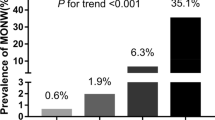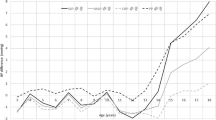Abstract
Background and aims: Metabolic syndrome (MS) leads to excess cardiovascular disease, including heart failure. Left ventricular hypertrophy (LVH) is common in MS patients, but it is unknown whether onsets of MS and LVH coincide. Herein, we tested the association between development of MS and of electrocardiographic LVH in a cohort of middle-aged individuals. Methods: We included 303 working subjects (mean age 43.0±6.2; 41% males), follo wed-up for 4.3±0.8 yr. ATP-III MS components were determined. Electrocardiographic LVH features were assessed by Sokolow and Cornell voltage indexes and Romhilt-Estes (RE) score. Results: At baseline, Cornell index was significantly higher in subjects with (no.=55; 18.2%) than in those without MS (12.8±6.4 vs 10.9±5.4 mm; p=0.023), while Sokolow index and RE score were not different. At follow-up, individuals who developed (no.=51) compared to those who did not develop MS showed a significant increase in Cornell voltage index (1.0±0.6 vs −0.55±0.3 mm; p=0.035) and RE score (0.17±0.17 vs −0.08±0.04; p=0.028). The change in Cornell index over time was directly correlated with the change in the number of MS components (r=0.133; p=0.02) and in homeostasis model assessment of insulin resistance (r=0.117; p=0.046). The association between MS onset and the increase in Cornell index/RE score was independent from confounders. Conclusions: In a young population of working subjects, the development of MS is associated with worsening features of LVH. Early LVH electrocardiographic screening in young subjects who develop MS should be considered and performed using Cornell voltage index.
Similar content being viewed by others
References
Earl S, Wayne H, Ali H. Increasing prevalence of the metabolic syndrome among U.S. Adults. Diabetes Care 2004, 27: 2444–9.
Salvatore M, Kristian B, Jacques G, et al. The metabolic syndrome and cardiovascular risk — A systematic review and meta-analysis. J Am Coll Cardiol 2010, 56: 1113–32.
Ingelsson E, Arnlöv J, Lind L, Sundström J. Metabolic syndrome and risk for heart failure in middle-aged men. Heart 2006, 92: 1409–13.
Lorell BH, Carabello BA. Left ventricular hypertrophy: pathogenesis, detection, and prognosis. Circulation 2000, 102: 470–9.
Gosse P. Left ventricular hypertrophy as a predictor of cardiovascular risk. J Hypertens Suppl 2005, 23: S27–33.
Sundström J, Lind L, Ärnlöv J, Zethelius B, Andrén B, Lithell HO. Echocardiographic and electrocardiographic diagnoses of left ventricular hypertrophy predict mortality independently of each other in a population of elderly men. Circulation 2001, 103: 2346–51.
Luis RP, MD, Ljuba B. Electrical remodeling in left ventricular hypertrophy — is there a unifying hypothesis for the variety of electrocardiographic criteria for the diagnosis of left ventricular hypertrophy? J Electrocardiol 2012, 45: 494–7.
Burchfiel CM, Skelton TN, Andrew ME, et al. Metabolic syndrome and echocardiographic left ventricular mass in blacks: the Atherosclerosis Risk in Communities (ARIC) Study. Circulation 2005, 112: 819–27.
Standards of medical care in diabetes. Diabetes Care 2004, 27(Suppl 1): S15–35.
Fadini GP, Marcuzzo G, Marescotti MC, de Kreutzenberg SV, Avogaro A. Elevated white blood cell count is associated with prevalence and development of the metabolic syndrome and its components in the general population. Acta Diabetol 2012, 49: 445–51.
Grundy SM, Cleeman JI, Daniels SR, et al. Diagnosis and management of the metabolic syndrome: an American Heart Association/National Heart, Lung, and Blood Institute Scientific Statement. Circulation 2005, 112: 2735–52.
Sokolow M, Lyon TP. The ventricular complex in left ventricular hypertrophy as obtained by unipolar precordial and limb leads. Am Heart J 1949, 37: 161–86.
Casale PN, Devereux RB, Alonso DR, Campo E, Kligfield P. Improved sex-specific criteria of left ventricular hypertrophy for clinical and computer interpretation of electrocardiograms: validation with autopsy findings. Circulation 1987, 75: 565–72.
Romhilt DW, Estes EH jr. A point-score system for the ECG diagnosis of left ventricular hypertrophy. Am Heart J 1968, 75: 752–8.
Konno T, Shimizu M, Ino H, et al. Differences in diagnostic value of four electrocardiographic voltage criteria for hypertrophic cardiomyopathy in a genotyped population. Am J Cardiol 2005, 96: 1308–12.
Chinali M, Devereux RB, Howard BV, et al. Comparison of cardiac structure and function in American Indians with and without the metabolic syndrome (the Strong Heart Study). Am J Cardiol 2004, 93: 40–4.
Arnlöv J, Lind L, Zethelius B, Several factors associated with the insulin resistance syndrome are predictors of left ventricular systolic dysfunction in a male population after 20 years of follow-up. Am Heart J 2001, 142: 720–4.
Bell DS. Heart failure: the frequent, forgotten, and often fatal complication of diabetes. Diabetes Care 2003, 26: 2433–41.
Anderson EA, Hoffman RP, Balon TW, et al. Hyperinsulinemia produces both sympathetic neural activation and vasodilation in normal humans. J Clin Invest 1991, 87: 2246–52.
Holmäng A, Yoshida N, Jennische E, et al, The effects of hyperinsulinaemia on myocardial mass, blood pressure regulation and central haemodynamics in rats. Eur J Clin Invest 1996, 26: 973–8.
De Kreutzenberg SV, Avogaro A, Tiengo A, Del Prato S. Left ventricular mass in type 2 diabetes mellitus. A study employing a simple ECG index: the Cornell voltage. J Endocrinol Invest 2000, 23: 139–44.
Author information
Authors and Affiliations
Corresponding author
Additional information
M.R. and F.B. contributed equally to the work.
Rights and permissions
About this article
Cite this article
Rigato, M., Boscari, F., Marcuzzo, G. et al. Development of metabolic syndrome and electrocardiographic features of left ventricular hypertrophy in middle-aged working subjects. J Endocrinol Invest 36, 1027–1031 (2013). https://doi.org/10.3275/9035
Accepted:
Published:
Issue Date:
DOI: https://doi.org/10.3275/9035




